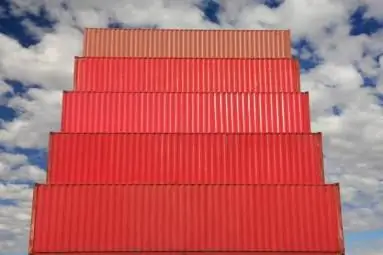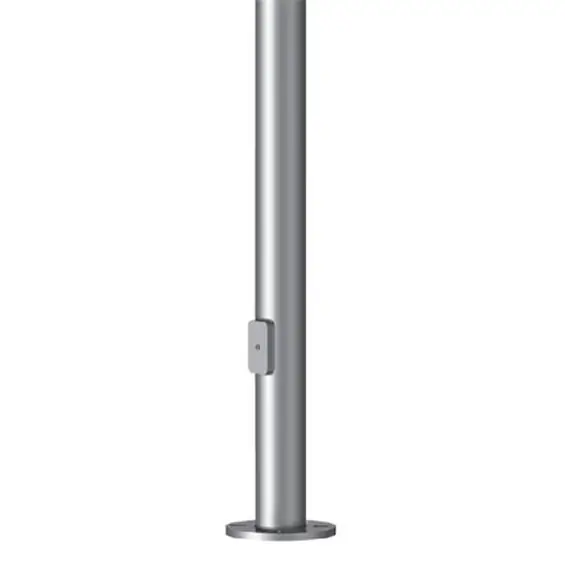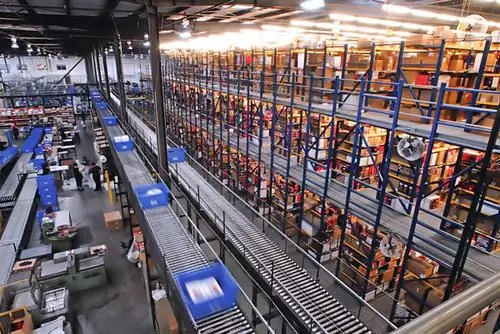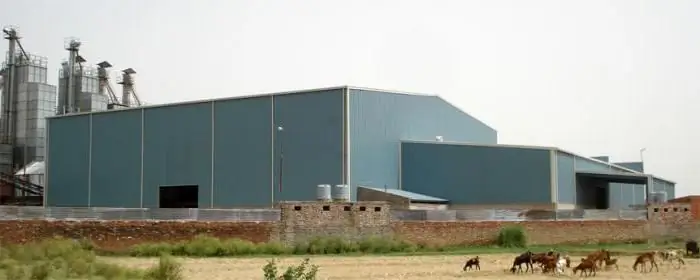2025 Author: Howard Calhoun | [email protected]. Last modified: 2025-01-24 13:10:37
The current production and trade process could not do without such an important facility as a warehouse. In logistics, the organization of its work is one of the conditions for the proper organization of the movement of inventories, products from the manufacturer to the consumer.
Types of warehouses that operate in modern conditions allow such premises to meet the most diverse requirements of participants in production and trade relations. Depending on the type to which the warehouse belongs, it performs certain functions.
In order to be able to properly plan the movement of goods from the enterprise to the buyer, logisticians must take into account the features of the presented premises. They create various conditions for the storage of goods and inventories. Therefore, the features of each type of warehouse should be understood and taken into account in their work by each logistician.
Main purpose
Before considering the main types of warehouses, you should understand the essence of this structural unit. Storage rooms perform a number of functions. A warehouse is a building, site or complex of structures that are used to store various commodity values. In such premisesaccumulated a certain amount of inventories, finished products. This allows you to flexibly respond to fluctuations in supply and demand in the goods market. At the same time, it becomes possible to synchronize the speed of movement of material assets in the technological cycles of manufacturers and the processes of delivery and sale of finished products.

All main types of warehouses are limited to a certain area, which is protected by the relevant organizations. Indoors, appropriate storage conditions are created.
In addition to the storage of commodity values, the presented structural units allow processing the products received here in order to maintain their quality. Warehouse personnel align incoming shipments by volume, time and range.
Structure
Types of warehouses, structures of premises and buildings are characterized by a certain structure. It may include several basic elements. This primarily includes storage buildings, as well as the surrounding area.
Each warehouse has shipping and loading systems. These include special equipment, areas for receiving or sending goods, ramps. Most of these facilities have internal transport. This category includes various warehouse equipment, the types of which depend on its features. These can be trolleys, loaders, escalators, elevators, etc.

The structural elements of the warehouse also include areas for processing goods. For example, these are packaging lines, packaging lines, a barcode system, as well as sorting and ordering. To be able to store goods, a warehouse requires the use of racks, containers, refrigeration equipment and other special systems to maintain the required quality of inventories. Any warehouse also has an accounting system. It can be computerized or manual. The first option in modern conditions is much more common.
Principles of Classification
Modern storage facilities are one of the most important nodes in logistics. There are different types of them. Warehouse types are distinguished according to different characteristics.
Storage facilities can range in size from small facilities to large buildings. According to the height of stacking goods, one-story and multi-story buildings are distinguished, in which the equipment can lift the load on a rack up to 24 m high.

By design, the warehouse can be open, semi-closed (has only a roof) and closed. According to the storage parameters, there are ordinary and special objects in which certain conditions are created (humidity, temperature, lighting).
The mechanization of such nodes can be different. There are warehouses where only manual labor of workers is used. Most often, storage rooms are partially or fully mechanized.
If different ways of communication adjoin the warehouse, this object is called port, rail, deep. On the basis of the range distinguishspecialized, mixed and universal objects.
Types of work
Each object of the represented type performs three basic operations. Types of work in the warehouse are designed to serve the input, internal and output flow of material assets. At the first stage, personnel and equipment unload the transport, as well as assess the quality and quantity of goods.
Internal flows are served in order to adequately move goods in the warehouse. Inventories are sorted, packaged, stored under appropriate conditions, etc.

The work of a warehouse with output flows is reduced to loading goods onto transport. In this regard, zones of loading, acceptance, storage, sorting, forwarding, as well as offices of service personnel and administration are allocated.
Classification of warehouses in Russia
In our country, a special classification is used, which allows us to divide the presented objects into main types. The purpose of warehouses, their characteristics allow us to distinguish several main groups.
At present, the PMC system, which was developed by the association of domestic companies, is most often used. This approach is very similar to the global warehouse classification principle. However, the RMS system takes into account, to a greater extent, the requirements of buyers and tenants for this type of property. This takes into account the main issues that first of all pay attention to the organizations of the central regions of our country.
All objects intended for storage of goods are divided into 4 groups. They are designatedwith Latin letters. When assigning a warehouse to one category or another, its design, location, main functions and features of the facility are taken into account. Its transport connection with other important objects for the organization, logistics areas is also evaluated.
The scale of the premises, the types of storage in the warehouses of products, the assortment must be taken into account. When choosing such objects of non-current assets, it is necessary to accurately calculate the needs of the company for the rational use of premises for storing commodity values.
Class A warehouse
Class A includes such types of warehouses at an enterprise or trade organization that were built in accordance with high modern building codes and requirements. These are single-story buildings with a height of more than 8 m. This allows you to install standard multi-story racks inside.

The floor in the room should not have defects. It is perfectly smooth and has an anti-friction coating. Inside the class A warehouse, a clear temperature regime is maintained. The gates are equipped with equipment for creating thermal curtains.
It is mandatory to use a modern fire safety system with the functions of extinguishing fires of powder or sprinkler type. Also, new security systems and video surveillance systems have been installed at such facilities. There are fiber optic computer communications. This allows you to maximize the view of the internal and external space with no "blind zones" whereno video equipment.
Gate, receiving and shipping areas in the class A warehouse have automated systems for opening doors, raising the ramp.
The access to such objects should be convenient. Most often they are located near the main transport routes. This type of warehouse is more often preferred by trading enterprises that sell products both wholesale and retail.
Class B
There are premises with somewhat simplified characteristics, however, not inferior in convenience to the previous category. Class B includes such species. The size of a warehouse in this category can be impressive. However, this is a multi-story building, which allows it to occupy a smaller area compared to class A buildings.
The height of the ceilings of such objects is in the range of 4.5-8 m. The floors are even, filled with asph alt or concrete. They do not have an anti-friction coating. The indoor temperature in winter does not fall below +10 °C.
The shipping area has a ramp, there is a security and fire safety system. Offices are combined with warehouses. They use modern communication systems, telecommunications.
The access to such warehouses may not be as convenient, but the building is located near the production or the city.
Class C and D warehouse
Considering the types of warehouses, it is necessary to note such classes as C and D. For many enterprises, this is the most acceptable option. Class C warehouse is a heated room with a ceiling height of 3.5 to 18 m.level from +8 to +14 ºС in winter.

Transport goes inside to carry out unloading and loading, for which the gate is always kept in the zero position. The floor covering can be concrete, asph alt or tile.
Class D has the lowest requirements. It can be an unheated basement, a bunker or a hangar. Civil defense facilities also fall into this category.
Depending on the category of premises, the cost of buying or renting is determined. Therefore, the company must take into account its needs. If additional amenities are not required, a low-class warehouse can be preferred. But in most cases, exploitation of an object of class A or B is simply indispensable. The costs of its maintenance and rent are paid off as a result of the organization's activities.
Public warehouse
Considering the types of warehouses, it should be noted that there are public facilities and the company's own premises. In the first case, the organization rents a room or part of it for the needs of its production.

This is necessary in case of a small turnover or the sale of seasonal goods. It is more profitable for a company to pay for the services of the owner of a public warehouse than to maintain its own facility. Such enterprises have less need for storage space.
The small size and proximity of the presented real estate to the consumer make it profitable in some cases. For example, whenthe company enters a new market, where forecasting is complicated by a number of factors, the public warehouse allows to reduce the financial risks of the company. At the same time, it is not required to attract additional investments.
The company will not need to hire qualified personnel to maintain the facility, and also to manage inventory. Many large enterprises use the services of a public warehouse. This allows you to store products as close as possible to the consumer, reduce transportation costs.
Own warehouse
However, not in all cases it is advisable for an organization to rent a room. Sometimes it's better to own your own property. This is necessary if the turnover is characterized by large volumes. Most often, such facilities are located in close proximity to production.
Also, many types of commercial warehouses use this system. If the sale is characterized by high volumes and is concentrated in the immediate vicinity of the buyer, it is more profitable to maintain your own warehouse. The organization is equipping it properly.
Most often this is class "A" or "B" property. Here accounting and management of commodity stocks by forces of the trading company is carried out. It hires qualified specialists, organizes the trading process (wholesale, retail), and also sets the cost of material assets that are offered to the consumer.
Large industrial enterprises also have their own warehouses. They store stocks, semi-finished products and finished products. If the turnover of such a companycharacterized by large volumes, it is more expedient to maintain your own warehouse than to rent a similar room.
Having considered the existing types of warehouses, we can conclude that when choosing such an object, their features should be taken into account. This will allow the enterprise to organize the system of storage and movement of inventory items as efficiently as possible. The minimum cost of maintaining and maintaining storage areas will optimize working capital and increase financial results. The process of organizing such objects is taken very seriously, making a number of mathematical calculations and research.
Recommended:
TSW - what is it? Customs warehouses and temporary storage warehouses

Often, the processing of the necessary customs documents may take some time. Therefore, cargoes are sometimes transferred to temporary storage warehouses. These are temporary storage warehouses, where the storage of goods has a limited period and is strictly regulated by the relevant legislation
Main operating materials: types, characteristics, purpose

Automotive equipment cannot work without fuel, lubricants and other materials. They have a number of special characteristics that depend on the features of the system. Operating materials correspond to the model of vehicles, perform many functions in the process of application. What they are, how they differ, will be discussed further
Main types and types of business plans, their classification, structure and application in practice

Each business plan is unique, because it is developed for certain specific conditions. But you need to familiarize yourself with the features of various types of business plans in order to understand their key features. Experts recommend doing this before compiling your own similar document
Steel support: types, types, characteristics, purpose, installation rules, operation features and applications

Steel poles today are most often used as lighting poles. With their help, they equip the lighting of roads, streets, courtyards of residential buildings, etc. In addition, such structures are often used as supports for power lines
Automatic warehouses and their equipment. Automated warehouse systems

Transportation of goods is the basis of production processes in warehouses of various types. Lifting and moving operations are less and less carried out manually and require the use of specialized equipment. At the current stage of development of the technical support of the warehouse, automatic components and assemblies are considered the most effective solution for this type of transportation problems

